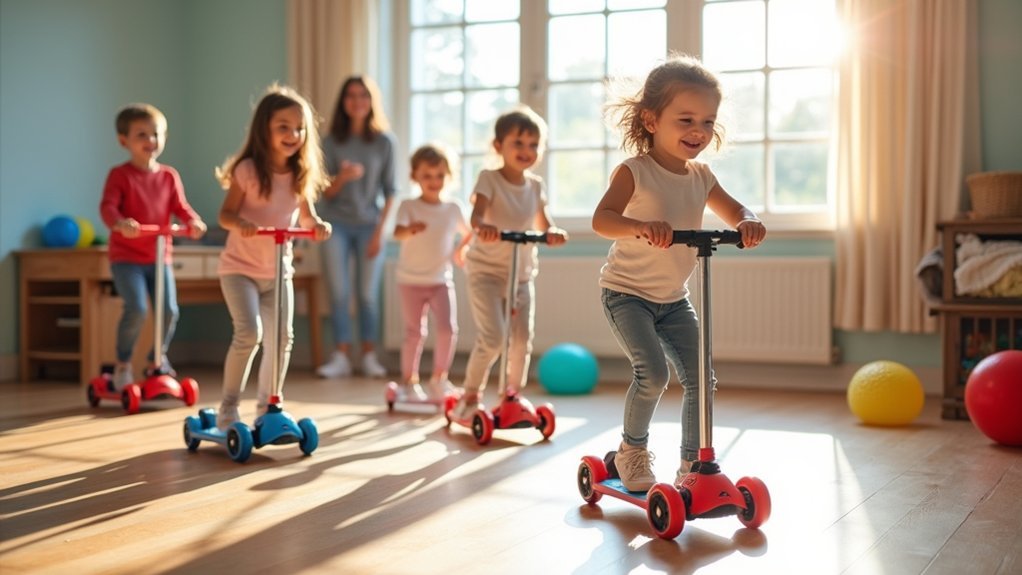Scooter boards offer versatile therapy options for developing core strength, bilateral coordination, and sensory integration. Always prioritize safety with proper supervision and equipment checks. Position children in prone, seated, or kneeling positions to target specific muscle groups and skills. Create engaging obstacle courses with directional challenges and reaching activities to enhance motor planning. Track progress consistently using SMART goals while keeping sessions fun and challenging. The therapeutic benefits extend far beyond what you might initially imagine.
Safety Guidelines for Therapeutic Scooter Board Use

Five essential safety precautions should be implemented when using scooter boards for therapy.
Always supervise children during scooter board activities to prevent accidents and guarantee their safety. Establish clear rules, particularly prohibiting standing on the board, which greatly reduces fall risks.
Use scooter boards exclusively on smooth, flat surfaces free of obstacles that could cause injuries during movement.
For all scooter board activities, insist that children wear proper safety gear including helmets and knee pads to protect against potential falls.
Before each therapy session, inspect the scooter board for damage or loose wheels. Regular maintenance checks guarantee the equipment remains safe for therapeutic use.
These safety guidelines create an environment where children can enjoy the developmental benefits of scooter board therapy while minimizing risks.
Building Core Strength Through Scooter Board Activities
With safety guidelines properly established, we can now focus on how scooter boards specifically target core strength development. These versatile tools engage multiple muscle groups simultaneously through various positions and movements.
| Position | Core Benefit | Motor Skills Enhanced |
|---|---|---|
| Prone | Strengthens back-extensors and upper arms | Upper body coordination |
| Seated | Requires core co-contraction for posture | Balance and stability |
| Kneeling | Maximizes core engagement due to higher center of gravity | Proprioception |
You’ll find that incorporating pulling activities, either with feet while seated or using a rope, activates both lower and upper body muscles. As your child regularly participates in these scooter board exercises, you’ll notice improvements in their posture, coordination, and overall core strength—fundamental components for developing advanced motor skills and physical confidence.
Sensory Integration Benefits of Scooter Board Therapy

Beyond physical strength development, scooter boards serve as powerful tools for sensory integration therapy.
When your child glides across the floor, they’re receiving vital vestibular and proprioceptive input that helps their nervous system feel regulated and balanced.
For children with SPD, ADHD, or Autism, scooter board activities can greatly improve their ability to process and respond to sensory information.
As they pull, push, and navigate on the board, they’re engaging multiple muscle groups that enhance body awareness and spatial orientation.
The heavy work involved in scooter board therapy is particularly beneficial for sensory seekers who crave intense input.
You’ll notice improved focus and attention after these activities as your child’s sensory needs are met through this dynamic form of play-based therapy.
Positioning Techniques for Different Therapeutic Goals
Selecting the right scooter board position dramatically impacts which therapeutic goals you’ll achieve during your child’s session. The prone position engages back-extensor muscles and upper arms, making it ideal for strengthening core muscles and upper body development. When your child lies supine, they’ll develop core co-contraction while self-propelling with a rope.
| Position | Primary Benefits | Best For |
|---|---|---|
| Prone | Strengthens upper body & back extensors | Children needing shoulder stability |
| Supine | Promotes motor planning & core engagement | Those working on vestibular processing |
| Seated/Kneeling | Develops balance & postural control | Advanced core strengthening |
For children ready for more challenge, try kneeling positions to raise their center of gravity and intensify core engagement. Cross-legged pulls or backward pushes can target specific muscle groups while enhancing coordination and motor skills.
Adaptive Scooter Board Games for Motor Planning

Creating engaging scooter board games transforms routine therapy into exciting challenges that naturally develop motor planning skills. When children maneuver through obstacle courses on their scooter, they’re constantly evaluating and adjusting their movements, enhancing their spatial awareness and body control.
Try incorporating role play where kids pretend to be delivery drivers using their hands to pull ropes while maneuvering to destinations. This strengthens bilateral coordination and midline crossing. You’ll notice improvements in both physical abilities and cognitive processing as they plan their routes.
Use clear verbal commands like “zoom under the bridge” or “glide to the red cone” to reinforce directionality concepts. By varying positions—prone, seated, or kneeling—you’ll target different muscle groups while keeping sessions fresh and challenging.
Children’s core strength develops as they stabilize themselves during these dynamic scooter activities.
Bilateral Coordination Exercises With Scooter Boards
Enhance your therapy sessions with partner push-pull activities where children work together to propel scooter boards using synchronized movements.
You’ll see remarkable progress when incorporating alternating limb movements, asking clients to push with opposite hand and foot combinations for balanced muscle development.
Cross-midline scooter games, such as reaching across the body to collect objects while maintaining balance, will strengthen neural pathways essential for reading and writing skills.
Partner Push-Pull Activities
When two children work together on scooter boards, they develop vital bilateral coordination skills that are difficult to achieve through solo activities. Partner push-pull activities create the perfect opportunity for children to experience resistance training while improving their coordination.
Set up activities where one child sits on the scooter while the other pulls them using a rope. You’ll notice immediate improvements in core strength and upper body muscles as they work against each other’s resistance.
These exercises provide rich proprioceptive input, enhancing sensory integration and body awareness.
Incorporate directional commands like “turn left” or “pull backward” to help children learn laterality concepts.
Beyond the physical benefits, you’re fostering essential social skills as children communicate and coordinate their movements—turning therapy into cooperative play that children actually look forward to.
Alternating Limb Movements
Three simple bilateral coordination exercises on scooter boards can dramatically improve a child’s neurological development.
Start with “commando crawls,” where children alternate arm and leg movements while lying on their stomachs, strengthening cross-hemispheric brain communication.
Next, try rope-pulling activities that encourage midline crossing. Have your child grasp a rope with both hands while seated on the scooter board, pulling themselves across the floor in a hand-over-hand motion.
Finally, implement push-pull exercises requiring one hand to push while the other stabilizes. This builds fine motor control while engaging different muscle groups simultaneously.
These alternating limb movements foster critical communication between brain hemispheres.
With consistent practice, you’ll notice significant improvements in your child’s balance, coordination, and overall motor planning abilities.
Cross-Midline Scooter Games
Cross-midline scooter games represent the next evolution in bilateral coordination therapy, building upon the alternating limb movements previously discussed.
When using a scooter board to encourage crossing midline, you’re facilitating essential connections between both hemispheres of the brain.
Incorporate these activities into your child’s sensory diet for maximum benefit:
- Pull-and-Turn Challenge – “4 pulls forward then turn right” develops motor planning while reinforcing spatial concepts.
- Object Retrieval – Place items on opposite sides of the body, requiring reaching across to collect them.
- Two-Handed Rope Pull – Use both hands simultaneously to pull along a fixed rope, enhancing bilateral coordination.
- Obstacle Navigation – Create courses with verbal cues like “pull past the blue cone” to combine language processing with physical movement.
These games simultaneously develop coordination, cognitive skills, and spatial awareness while making therapy enjoyable.
Creating Scooter Board Obstacle Courses for Skill Development
Setting up thoughtfully designed obstacle courses transforms standard scooter board therapy into dynamic skill-building adventures. By incorporating cones, ramps, and tunnels, you’ll create opportunities for children to problem-solve while receiving heavy work input that regulates their sensory system.
Arrange obstacles that encourage midline crossing—place objects that require reaching across the body to grab or navigate around. Issue specific verbal commands like “push through the tunnel” or “circle the red cone” to reinforce directional concepts and language skills.
For optimal growth, adjust course difficulty based on individual abilities. Raise ramps for advanced users or decrease distances between obstacles for beginners.
Always prioritize safety by establishing clear rules and maintaining adequate space around the obstacle course to prevent collisions or falls.
Proprioceptive and Vestibular Input Through Scooter Activities
Scooter boards deliver powerful proprioceptive and vestibular input that’s essential for children’s sensory development.
Sensory-rich scooter board play provides the developmental building blocks children need for body awareness and balance.
When your child propels themselves on a scooter board, they’re engaging muscles and joints while stimulating their vestibular system, improving balance and spatial awareness.
For maximum sensory benefits, try these scooter board activities:
- Push-Pull Partners – Have children work in pairs to push and pull each other, building strength while fostering social connections.
- Tunnel Adventures – Create tunnels for children to navigate through, enhancing proprioceptive input and spatial orientation.
- Treasure Hunts – Place objects around the room for children to collect while on scooter boards.
- Spinning Challenges – Supervised spinning activities provide intense vestibular input that many sensory seekers crave.
These activities help children regulate sensory input, improving focus and motor planning skills.
Measuring Progress and Setting Goals With Scooter Board Therapy
Effective therapy requires a systematic approach to tracking your child’s development and establishing clear objectives.
Begin by documenting baseline measurements of core strength, bilateral coordination, and motor planning abilities before you use the scooter board for the first session.
Set specific goals using the SMART framework—ensure they’re measurable, achievable, and time-bound. Focus on improving balance, coordination, and strength through targeted activities.
Track progress consistently, noting both qualitative improvements (following commands) and quantitative advances (completing tasks in less time).
Don’t forget to include your child’s feedback about comfort and enjoyment—this helps maintain engagement and allows you to adjust activities accordingly.
As your child masters initial challenges, introduce new scooter board exercises to promote continued skill development and prevent plateaus in their therapeutic journey.
Frequently Asked Questions
What Is the Proper Way to Use a Scooter Board?
Guarantee wheels are unfastened on a safe surface. You’ll want to maintain good posture while lying, sitting, or kneeling on the board. Use your hands or feet to propel yourself in different directions.
What Are the Benefits of Scooter Board Activity?
Scooter board activities strengthen your core and upper body, improve your coordination, and provide sensory input. You’ll develop bilateral skills, enhance stability, and enjoy social interaction while having fun during these dynamic exercises.
What Is the Proprioceptive Input of a Scooter Board?
The proprioceptive input of a scooter board occurs when you’re propelling yourself and engaging muscles. Your joints and muscles receive feedback about body position and movement, helping you develop better body awareness and coordination.
What Age Are Scooter Boards For?
Scooter boards are ideal for children aged 3 and up. You’ll find they’re appropriate for preschoolers through elementary-aged kids, including those with special needs. They’re most effective when activities match your child’s developmental level.
In Summary
You’ve now got all the tools to incorporate scooter boards into your therapy practice effectively. Remember to prioritize safety while customizing activities to meet your client’s specific needs. By tracking progress and gradually increasing challenges, you’ll help develop core strength, motor planning, and sensory integration skills. With creativity and consistency, you’ll transform simple scooter boards into powerful therapeutic tools that deliver fun alongside meaningful developmental gains.





Leave a Reply